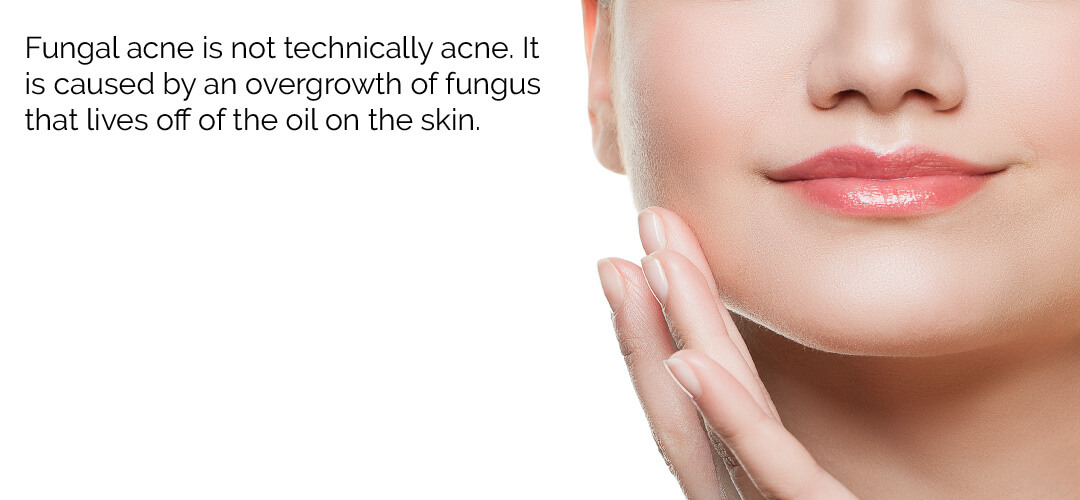There are certain places that you expect to find fungus. Damp basements, under rocks in the woods, or grilled and served up at a steakhouse in the form of mushrooms. One place you don’t expect to find fungus — your skin! More and more people are experiencing “fungal acne.” But what is it exactly, and how can it be treated and prevented? Let’s take a look:
What is Fungal Acne?

The first thing you should know about fungal acne is that it’s not technically acne. “People call it fungal acne because it does look like acne,” Adam Friedman, a dermatologist at the George Washington University School of Medicine, told Gizmodo. “It can even confuse the well-trained eye of a dermatologist sometimes.”
While fungal acne (or as it is known in the dermatological world, “Pityrosporum folliculitis” or “Malassezia folliculitis”) may look very similar to both bacterial and hormonal acne, the difference between the two is the cause. Acne is caused by bacteria, whereas fungal acne is caused by (you guessed it) an overgrowth of fungus! This overgrowth in fungus lives off of the oil on the skin, and it doesn’t discriminate. It can be caused by both the natural oil (sebum) produced by our skin, or the excess oil that is found in our skincare products.
Fungal acne looks different from traditional acne. Acne that results from bacteria or hormones typically has blackheads, pustules, papules, or cysts. But this consists of groups of small bumps under the skin’s surface that are typically itchy. Because the fungus lives on oil, breakouts are typically found on the oiliest (or sweatiest) parts of our bodies. These include the forehead, t-zone, chin, upper back, chest, and shoulders.
How is it Caused?
We know that fungal acne lives off of oil, but what exactly does that mean? There are plenty of people with oily skin who have never experienced this type of acne before. That is because there are other factors that can throw off the balance in our skin, which results in this fungus. “Our skin is like a giant petri dish,” Adam Friedman tells Gizmodo. “It sounds disgusting, but there are over 500 bacterial species, not counting viruses or fungi. They’re like an extra layer of protection, they fight off potential pathogens. They keep everything in check. But if you disrupt that balance, other things can take over.”
There are a few different causes of fungal acne according to MD Acne, who provided the following list of culprits:
Climate: Because yeast thrives in warm, humid places, fungal acne is more common these types of climates and seasons. Interestingly, 56% of people with acne in the Philippines (hot and humid!), have both regular bacterial acne and fungal acne—a much higher rate than average!
Antibiotics: long-term use of topical antibiotics such as clindamycin or oral antibiotics such as doxycycline and minocycline can make it worse. By killing off bacteria (both bad and good!) antibiotics allow the fungi on the skin to proliferate.
Hygiene: Starting a new exercise program, wearing the wrong workout clothes, and/or leaving sweaty clothes on your body for too long can all lead to fungal acne and what’s known as folliculitis.
Skincare Products: Did we also mention yeast feed on oil? If you’re using skincare or makeup products that contain oil (even small amounts), it could be a trigger.
Diet: While diet isn’t typically the initial cause of a fungal acne outbreak, once there is an existing imbalance, your diet—if high in sugar (yeast’s other favorite food!)—can certainly be a contributing factor!
How to Treat Fungal Acne
Because fungal acne is sometimes difficult to diagnose, that means it can also be tough to treat. A lot of people assume that it can be treated the way hormonal and bacterial acne is, so they use products that contain benzoyl peroxide, or salicylic acid. This can oftentimes make it worse. Antibiotics like clindamycin are sometimes prescribed to treat bacterial acne, but they can also inadvertently be the cause of fungal acne as long-term use can disrupt the skin’s delicate microbiome giving the fungus a perfect place to thrive.
But fear not, there are several effective treatments that are available for fungal acne. Dermatologists recommend that you first try the popular dandruff shampoo Selsun Blue. It sounds a little unconventional, but it works! Just be sure you’re letting it sit on the skin for a minimum of 60 seconds (but you should try letting it sit on the skin for 5 minutes total), otherwise, it won’t get the job done. Dermatologists recommend that you do this every other day for at least 2 months. Once the fungal acne is cleared, it is important that you continue using the shampoo once a week for another few months in order to prevent it from returning.
In conjunction with the medicated shampoo, you should make some lifestyle adjustments as well. Switch to oil-free skincare products, change out of sweaty clothes ASAP, and limit your sugar intake.
If you have tried all of those things and the acne persists, it’s time to see a dermatologist. Shereene Idriss, a cosmetic dermatologist at Union Square Laser Dermatology in New York City explains to Allure magazine that, “given the fact that fungal acne is due to yeast overgrowth within the hair follicles, systemic oral medication is usually necessary to reach deep into the follicle.” She continues, “I usually recommend that my patients plan a sweat session (i.e. workout) 24 hours after they take the oral anti-fungal pill, as the medication has been proven to be secreted through the sweat glands into the hair follicles and onto the skin, which allows for a much more efficient and effective treatment of fungal acne.”
Bottom Line
Even though fungal acne isn’t technically acne, it’s still just as irritating as the blemishes caused by bacteria or hormones. If you want to learn more about it, the website Simple Skincare Science did an incredibly in-depth and well-researched article all about it!

